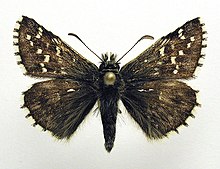
The dingy skipper is a species of butterfly in the family Hesperiidae.

Pyrgus malvae, the grizzled skipper, is a butterfly species from the family Hesperiidae. It is a small skipper (butterfly) with a chequered pattern on its wings that appears to be black and white. This butterfly can be found throughout Europe and is common in central and southern regions of England. The butterfly prefers three major types of habitat: woodland, grassland, and industrial. Referenced as a superspecies, Pyrgus malvae includes three semispecies: malvae, malvoides, and melotis. Eggs are laid on plants that will provide warmth and proper nutrition for development. As larvae, their movement is usually restricted to a single plant, on which they will build tents, unless they move onto a second host plant. Larvae then spin cocoons, usually on the last host plant they have occupied, where they remain until spring. Upon emerging as adult butterflies, grizzled skippers are quite active during the day and tend to favour blue or violet-coloured plants for food. They also possess multiple methods of communication; for example, vibrations are used to communicate with ants, and chemical secretions play a role in mating. Exhibiting territorial behaviour, males apply perching and patrolling strategies to mate with a desired female.

Aporia crataegi, the black-veined white, is a large butterfly of the family Pieridae. A. crataegi is widespread and common. Its range extends from northwest Africa in the west to Transcaucasia and across the Palearctic to Siberia and Japan in the east. In the south, it is found in Turkey, Cyprus, Israel, Lebanon and Syria. It is not usually present in the British Isles or northern Scandinavia.

The small mountain ringlet or mountain ringlet is a butterfly of the family Nymphalidae. It is found in mountainous regions of southern and central Europe.
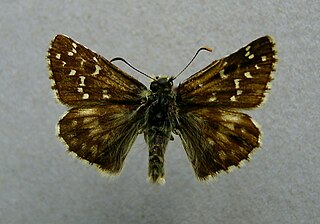
The Large Grizzled skipper is a species of skipper butterfly.
Pyrgus warrenensis, the Warren's skipper, is a species of skipper. It is a strictly Alpine species.

Oberthür's grizzled skipper is a species of skipper.
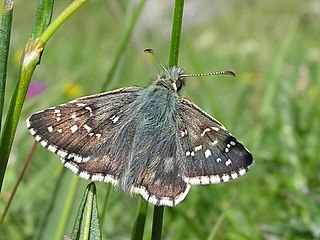
The Olive Skipper is a species of skipper.

The Cinquefoil Skipper is a species of skipper butterfly.
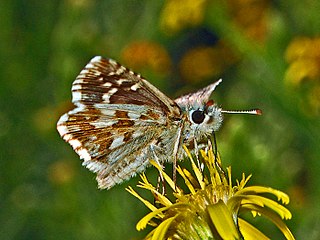
The rosy grizzled skipper is a species of skipper.
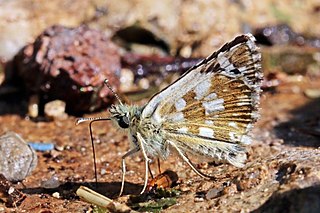
The sandy grizzled skipper is a species of skipper. It has a restricted range in southeastern Europe with a small relict population in central Spain.

Spialia sertorius, commonly known as the red-underwing skipper, is a butterfly of the family Hesperiidae.

Carcharodus alceae, commnly known as the mallow skipper, is a species of butterfly of the family Hesperiidae.

Zygaena exulans, the mountain burnet or Scotch burnet, is a moth of the family Zygaenidae.

The safflower skipper is a species of skipper butterfly.
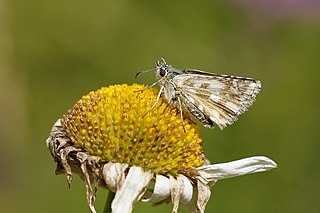
The Dusky Grizzled Skipper is a species of skipper butterfly.

Oeneis glacialis, the Alpine Grayling, is a butterfly of the family Nymphalidae. It is found in the Alps at heights of 1400 to 2900 m above sea level.

Boloria polaris, the Polaris fritillary, is a butterfly of the family Nymphalidae. It is found in northernmost Scandinavia, North America and in Greenland. It is also found in northeastern Russia and across the Palearctic to Chukotka. It is one of only six butterfly species found on Canada's Ellesmere Island.

Muschampia floccifera, the tufted skipper or tufted marbled skipper, is a butterfly of the family Hesperiidae.

Pyrgus malvoides, the Southern Grizzled Skipper, is a species of skipper.
